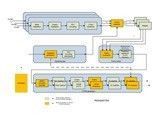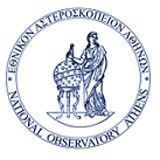
-
StatusCompleted
-
Status date2020-03-20
-
Activity Code1B.017
OFDM techniques are currently well established in terrestrial mobile networks but have not found up to now significant use in the space community. The project had an exploratory nature evaluating possible advantages of OFDM-like waveforms in broadband satellite applications.
In addition to possible mobile applications, also fixed applications were explored. Mobile applications investigations concentrated on possible enhancement of the DVB-SH standards (like MIMO and interactive application supports). Fixed application investigations concentrated on the possible use of OFDM-like techniques to improve the spectral efficiency of DVB-RCS like systems as well as the impact of such techniques in simplifying the implementation of flexible multibeam payloads.
The main objective of the work was to investigate the potentiality of OFDM based techniques in satellite communications. The DVB-SH standard, although being much optimized for broadcasting, presents some shortcomings making it not suitable for other applications (notably, the interactive ones). Moreover, new advanced communication processing techniques, currently being pushed in the terrestrial field, can potentially increase the capacity of the radio-link.
Hence, one of the main topics was to investigate future upgrading to the DVB-SH waveform able to extend the field of applicability of the OFDM techniques from the pure TV broadcasting to more general applications while having flexibility on service configuration and improving the efficiency of the physical layer through the addition of advanced techniques like MIMO.
Furthermore, the potential advantages of OFDM in a fixed scenario were also addressed with a two-fold aims: i.e., that of improving the spectral efficiency of the RF links and that of providing more efficient ways of implementing on-board payloads able to meet the very demanding requirements of future satellites for broadband interactive networking.
Two system alternatives for the Forward Link access of the fixed scenario were considered, one for Single Feed Per Beam payload configurations and one for active antenna payload configurations. Symbol synchronous operation of the ground elements was addressed in order to achieve on-board processor simplification.
Multiple access techniques (Single-Carrier FDMA) able to reduce envelope fluctuations were investigated for the return link and the requirement to operate symbol synchronous is the most important issue in this proposal.
A number of relevant focus areas were identified for the mobile scenario, leading to the following major addressed issues: MIMO transmission to increase spectral efficiency; introduction of QoS flexibility adapting MOD-COD and interleaver profile to each service topology through physical layer pipes (PLP); support of high mobility; support of fast acquisition; pilots and preambles for synchronization and channel estimation; PAPR reduction techniques.
For the fixed scenario, the use of OFDM-like techniques brings advantages both for improving the spectral efficiency of satellite links (thanks to the orthogonality spacing of the carriers) and to implement sophisticated digital on-board processing for signal filtering, routing and switching, at a much reduced HW complexity with respect to current state-of-the art. Network-wide symbol synchronous operation is generally required to achieve the advantages promised by these techniques. However, the investigated study cases proved the feasibility of the proposed system concept.
Both the SC-FDMA techniques considered for the return link multiple access showed a significant advantage over non-precoded OFDM in a non-linear channel thanks to the lower signal envelope fluctuation.
The mobile scenario investigations lead to the definition of a new OFDM air interface baseline structure organized according to the DVB-SH standard and named DVB-SH*. The introduction of PLP allowed to create a physical layer frame containing different sections with their own QoS requirements for the transported services. Furthermore, the adoption of MIMO techniques as Golden Code or Spatial Multiplexing showed that a doubling of the spectral efficiency of current DVB-SH system comes at about 3dB power penalty, gaining about 2.5dB with respect to a same efficiency SISO scheme.
A new waveform proposal derived from the current DVB-SH was the main outcome of the work concerning the mobile scenario. The DVB-SH original waveform has been modified mainly to support physical layer pipes, MIMO and a so-called P1 preamble, with the optional possibility to use PAPR reduction techniques.
The proposed waveform format is summarized in the signal generation diagram below. In particular, a frame organizer receives data from each data pipe and is in charge of correctly placing the data and signalling to the correct position into each frame. A frame composer is then in charge of correctly sequencing on the channel the different pipes.
Based on this proposed waveform, a block scheme of a compliant receiver was derived for both the SISO and the MIMO cases. Full simulations of the proposed waveforms were performed in realistic channel conditions (satellite, terrestrial and hybrid) for both SISO and different MIMO algorithms.
For the fixed scenario, digital payloads operating in a transparent bent-pipe mode were considered (regenerative payloads are currently regarded as scarcely flexible). Complexity of such payloads, given the very large bandwidth to be processed, is very challenging: It was shown that the use of OFDM-based techniques may render such payload complexity more manageable whilst also improving the system spectral efficiency.
The project was structured in seven Tasks.
Task 1: Benchmark systems analysis and definition of the system scenarios
Task 2: Customization of the OFDM air interface to the considered scenarios
Task 3: High level design of the ground and payload equipments
Task 4: On-ground modem and on board DSP techniques design
Task 5: End-to-end performance validation
Task 6: Assessment of the cost benefits/impacts of the devised air interfaces to the overall satellite network cost
Task 7: Recommendations for further work and standardization
The project has been concluded. From the research activities of this project, a new technical solution has been submitted to the RCS Next Generation (RCS-NG) call for technology closed in May 2009. Thanks to the support of this Team and in collaboration with another ESA-Project (i.e., ESA Contract n. 22554/09/NL/US, “2nd Generation DVB-RCS Standardization Support”) this proposed solution has been inserted as an option in the next RCS-NG normative document. Since the RCS-NG activities will continue also in 2010 and 2011, it is important to look at the extension to mobile environments and the adaptation for mesh topologies.
Regarding the mobile scenario, since the market hosts already several waveforms serving the purpose of broadcasting data from satellite to handhelds or mobile users (DVB-SH, ESDR, DVB-NGH, CMMB, S-DMB), it is predictable that any new standard will have difficulties to enter into the market. Therefore, it has been proposed in this project that the new technologies developed here should rather be integrated into existing standards. The technical outcomes of the study may be involved in various standardization bodies, including DVB-NGH, 3GPP LTE-Advanced and ETSI-SES.






